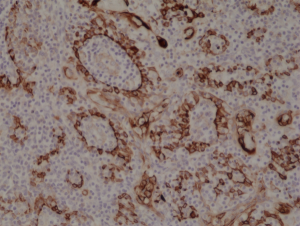anti-Cytokeratin-17 (human) Rabbit Monoclonal (RM351)
| Code | Size | Price |
|---|
| REV-31-1237-00-R100 | 100 ul | £455.00 |
Quantity:
Prices exclude any Taxes / VAT
Overview
Antibody Isotype: Rabbit IgG
Antibody Clonality: Recombinant Antibody
Antibody Clone: RM351
Regulatory Status: RUO
Target Species: Human
Applications:
- Immunohistochemistry (IHC)
- Western Blot (WB)
Shipping:
Blue Ice
Storage:
+4°C
Images
Documents
Further Information
Alternate Names/Synonyms:
CK17; CK-17; Cytokeratin 17
Concentration:
N/A
EClass:
32160000
Form (Short):
liquid
Formulation:
Liquid. 50% Glycerol/PBS with 1% BSA and 0.09% sodium azide.
Handling Advice:
Avoid freeze/thaw cycles.
Immunogen:
A peptide corresponding to residues in human Cytokeratin 17 (CK-17).
Long Description:
Recombinant Antibody. This antibody reacts to human Cytokeratin 17 (CK-17). Applications: WB, IHC. Source: Rabbit. Liquid. 50% Glycerol/PBS with 1% BSA and 0.09% sodium azide. Cytokeratins are keratin proteins found in the intracytoplasmic cytoskeleton of epithelial tissue (at least 20 different polypeptides). They are an important component of intermediate filaments, which help cells resist mechanical stress. Expression of these cytokeratins within epithelial cells is largely specific to particular organs or tissues. The subsets of cytokeratins which an epithelial cell expresses depends mainly on the type of epithelium, the moment in the course of terminal differentiation and the stage of development. Thus a specific cytokeratin expression profile allows the identification of epithelial cells. Furthermore, this applies also to the malignant counterparts of the epithelia, (carcinomas). Cytokeratin subtype expression patterns are used to an increasing extent in the distinction of different types of epithelial malignancies. The cytokeratin antibodies are not only of assistance in the differential diagnosis of tumors using immunohistochemistry on tissue sections, but are also a useful tool in cytopathology and flow cytometric assays. Cytokeratin-17 is a type I cytokeratin. It is found in nail beds, hair follicles, sebaceous glands and other epidermal appendages. Cytokeratin-17 may be used to aid in the identification of squamous cell carcinomas in various tissues including the cervix, lung, and oral cavity. Mutations in the gene encoding this protein lead to PC-K17 (previously known as Jackson-Lawler) type pachyonychia congenita and steatocystoma multiplex.
NCBI, Uniprot Number:
Q04695
Package Type:
Vial
Product Description:
Cytokeratins are keratin proteins found in the intracytoplasmic cytoskeleton of epithelial tissue (at least 20 different polypeptides). They are an important component of intermediate filaments, which help cells resist mechanical stress. Expression of these cytokeratins within epithelial cells is largely specific to particular organs or tissues. The subsets of cytokeratins which an epithelial cell expresses depends mainly on the type of epithelium, the moment in the course of terminal differentiation and the stage of development. Thus a specific cytokeratin expression profile allows the identification of epithelial cells. Furthermore, this applies also to the malignant counterparts of the epithelia, (carcinomas). Cytokeratin subtype expression patterns are used to an increasing extent in the distinction of different types of epithelial malignancies. The cytokeratin antibodies are not only of assistance in the differential diagnosis of tumors using immunohistochemistry on tissue sections, but are also a useful tool in cytopathology and flow cytometric assays. Cytokeratin-17 is a type I cytokeratin. It is found in nail beds, hair follicles, sebaceous glands and other epidermal appendages. Cytokeratin-17 may be used to aid in the identification of squamous cell carcinomas in various tissues including the cervix, lung, and oral cavity. Mutations in the gene encoding this protein lead to PC-K17 (previously known as Jackson-Lawler) type pachyonychia congenita and steatocystoma multiplex.
Purity:
Protein A purified.
Source / Host:
Rabbit
Specificity:
This antibody reacts to human Cytokeratin 17 (CK-17).
Transportation:
Non-hazardous
UNSPSC Category:
Primary Antibodies
UNSPSC Number:
12352203
Use & Stability:
Stable for at least 1 year after receipt when stored at -20°C.



